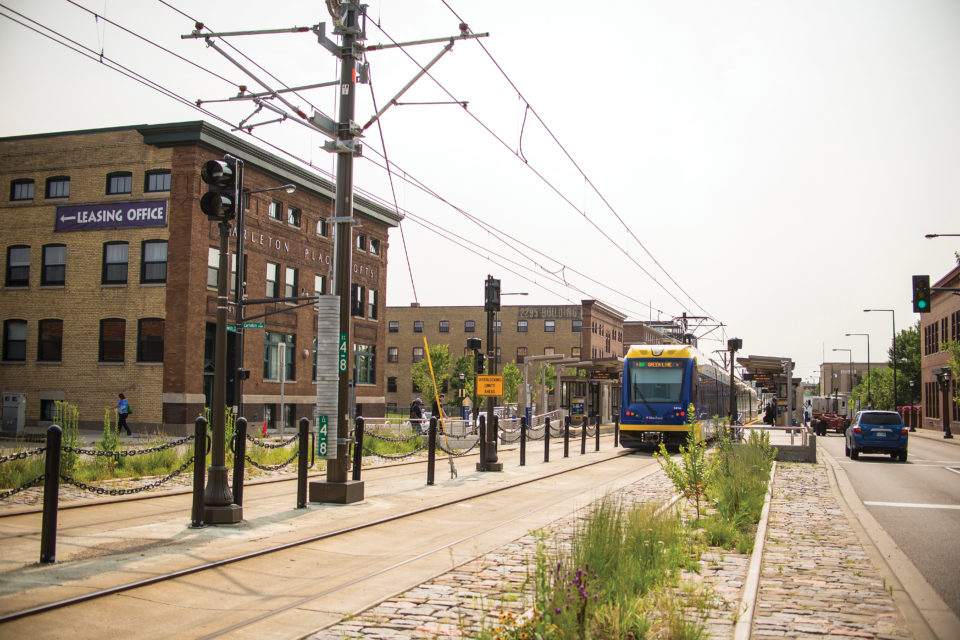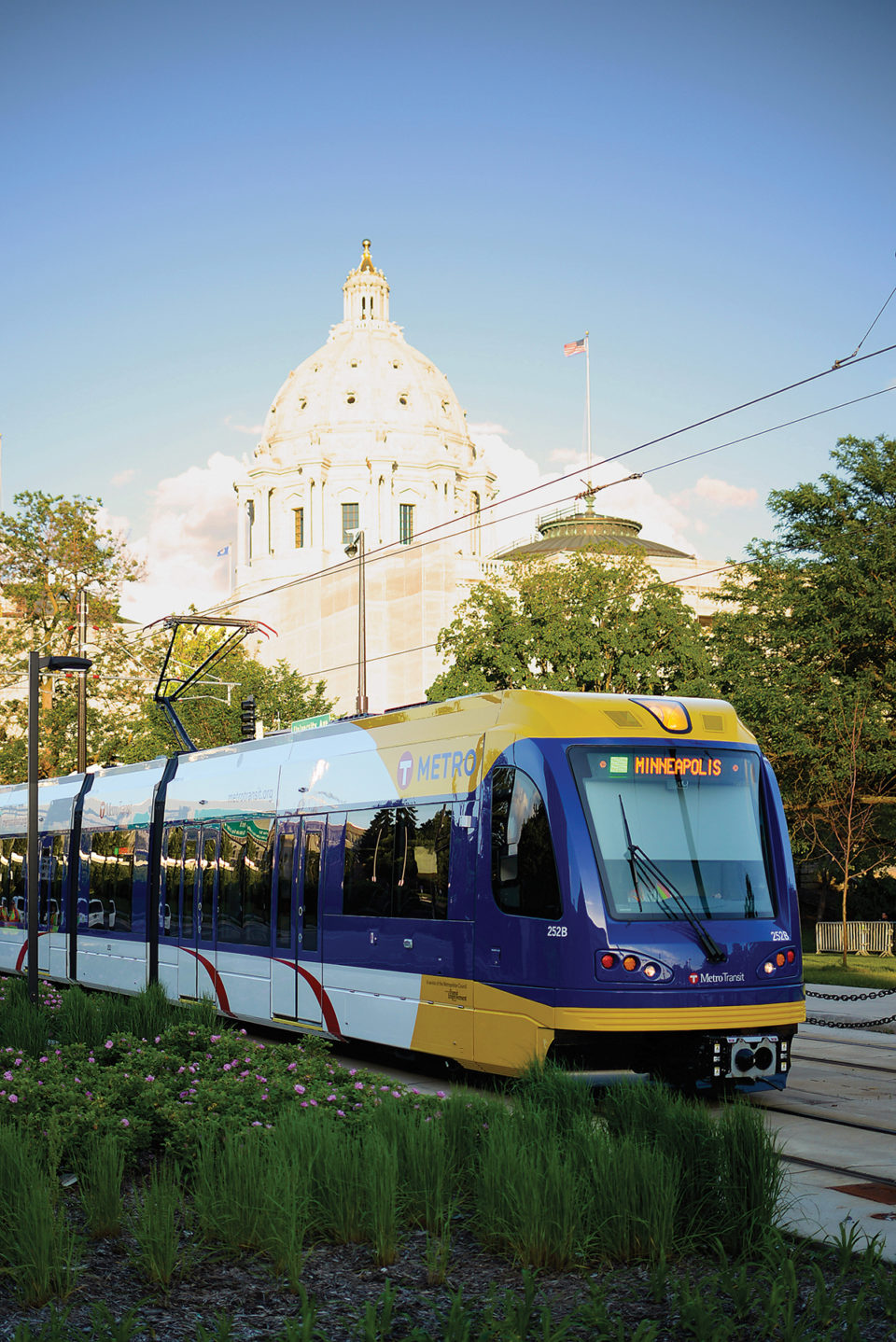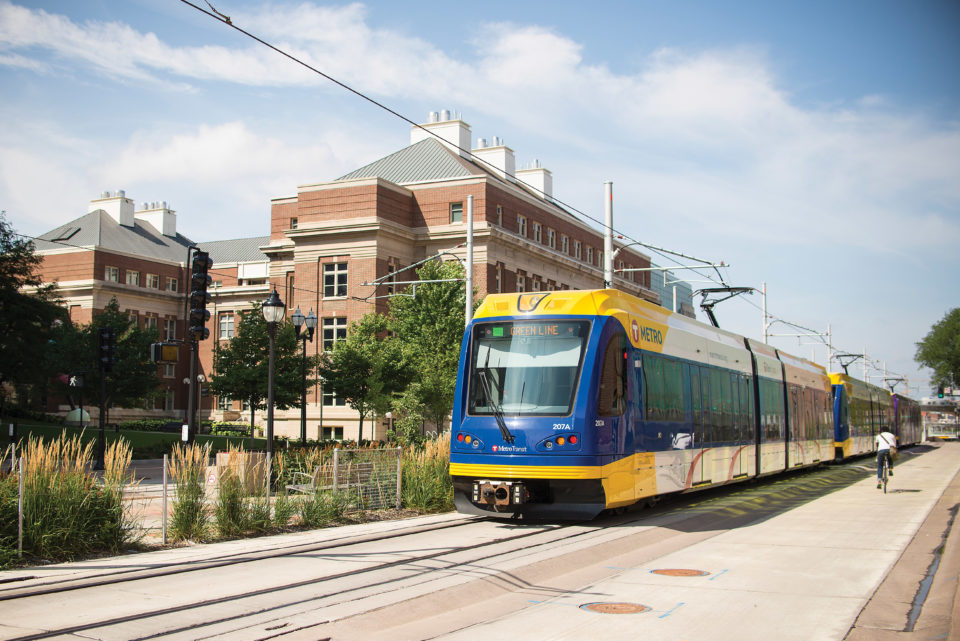
University Ave, Minneapolis (credit: Eric Wheeler, MetroTransit)
Project Length: 11 miles
Right-of-Way Width: 100 feet
Participating Agencies: Metro Transit, Metropolitan Council, Ramsey County, City of Minneapolis, & City of Saint Paul
Timeline: Planning started 2001
Construction, 2011 – 2012
Transit service started 2014
Cost: $957 million, including $5 million for green investments
Goals
Mobility: Provide high-quality, regular, and reliable transit service connecting Minneapolis and St. Paul.
Stormwater management: Reduce stormwater runoff and improve water quality.
Economic development: Improve connectivity between Minneapolis and St. Paul, enhancing access to a thriving and vibrant corridor.
Overview
The METRO Green Line is an eleven-mile light rail route connecting downtown Minneapolis and downtown St. Paul, two adjoining cities that together make the core of a metropolitan region. The route cuts through highly developed large tracts of industrial, commercial, and residential areas and links five major centers of activity, including the University of Minnesota.
University Avenue, a significant regional transportation corridor, was fully reconstructed to accommodate the light rail line, providing the opportunity to rethink the corridor’s ability to capture and manager stormwater runoff. Significant investment in green stormwater infrastructure leverages the local hydrology to treat stormwater through infiltration, reducing stormwater pollution reaching the Mississippi River.
Design Details
Rain gardens, bioretention planters, infiltration trenches, permeable pavers and tree trenches work along the corridor and on side streets to absorb and filter stormwater. Public art is integrated into the design of infiltration trenches and transit stations along the corridor, creating a sense of place.
Tree trenches, with over 1,000 planted trees, line five miles of University Avenue. Stormwater runoff enters the trenches through permeable pavers and surface catch basins, and is then stored in rock-filled cells. Planted trees along the trenches absorb and filter stormwater, and stormwater is slowly released into the underlying soil. In the case of extreme rain events, excess stormwater is carried into the storm sewer.
Infiltration trenches run underneath two side streets in St. Paul. Stormwater flows through storm drains into large pipes under the street. These pipes—punched with thousands of holes—are buried in long trenches filled with golf-ball-sized rocks. The water fills the pipes and a controlled release through the holes allows the water to infiltrate the rocks and soil. Excess stormwater from extreme rain events is carried into the storm sewer.
Bioretention planters were implemented on five side streets. Curb openings channel stormwater from the roadway into the planter, where hardy native plants, modified soil, and sand filter stormwater while recharging the ground reservoir.
Rain gardens were built on four adjacent streets along the rail corridor, improving water quality in the project area.
Permeable pavers were applied as the surface treatment above the tree trenches, providing for infiltration of rain water from the sidewalk as well as improved air exchange between the surface and the soil.

University Ave, St. Paul (credit: Eric Wheeler, MetroTransit)
Keys to Success
Unique partnership. Between 2007 and 2016, the Central Corridor Funders Collaborative was formed to align interests and identify potential housing, economic development, and greening opportunities along the Green Line. The Funders Collaborative worked to complement the work of the municipal agencies. The members have made more than 160 grants, totaling nearly $12 million dollars of investment.
Leverage multiple funding sources. The cost of the green infrastructure portion of the project leveraged numerous funding sources at multiple levels of government, including a state Clean Water Fund grant, regional funding from the Metropolitan Council, local funding from the City of St. Paul, and in-kind contributions from the Capital Region Watershed District.
Monitor progress. Monitoring equipment was installed to assess the bioretention facilities’ performance, and results are expected to inform future green infrastructure investments.
Lessons Learned
Align utility infrastructure installation. Redundant efforts and extended timelines can be reduced by closely coordinating activities.
Meet early and often with stakeholders. Stakeholders can positively influence the outcome of a project, and potential conflicts can be addressed early. Many design elements were influenced through stakeholder outreach, including new curbs and gutters to improve the stormwater elements of the project.
Invite participation. Work with unique partnerships, art organizations, neighborhood groups, and local businesses to enrich and fine-tune project goals to meet the needs of the community.
Outcomes

University Ave, Minneapolis (credit: Eric Wheeler, MetroTransit)
Approximately 50% of stormwater runoff has been mitigated by the green infrastructure.
80 pounds of phosphorous and 40,000 pounds of sediment are treated and removed by the green infrastructure annually.
The project utilized materials with a high recycled content, including over 30% recycled steel for the 12,000 tons of track rail installed.
Over 1 million transit riders a month enjoy service between the two cities. Passengers can access the Green Line at 18 stations along the route.
The neighborhoods along the Green Line have experienced more than $3 billion in commercial and residential development.
13,700 housing units have been added or planned within one-half mile of the line.